



Suggested Citation: Malyan, Ankur, and Vaibhav Chaturvedi. 2021. Carbon Capture, Utilisation and Storage (CCUS) in India: From a Cameo to Supporting Role in the Nation’s Low-Carbon Story. New Delhi: Council on Energy, Environment and Water.
This issue brief highlights the escalating momentum of Carbon Capture, Utilisation, and Storage (CCUS) technology in India amidst a growing net-zero debate across the globe. CCUS has been a topic of discussion for more than two decades, but it has not gained any focus because of limited research, finance and policy support. This brief presents an assessment of relevant documents of the Government of India, critical global literature, and announcements by Indian industries in order to unravel the changing focus on CCUS technology. Though CCUS is far from being mainstream in the climate debate, this study intends to present the way forward to sustain the gained momentum for CCUS in India.
The role of carbon capture, utilisation, and storage (CCUS)1 in climate change mitigation has been a topic of debate for over two decades. The Intergovernmental Panel on Climate Change’s (IPCC) Special Report on Global Warming of 1.5°C and the recent series of announcements by nations on net-zero have enthused the proponents of this technology, given the potential role offsets are expected to play in a net-zero world. In India, stakeholders have largely remained sceptical of the CCS technology because of the negligible progress on the deployment of this technology in the last two decades, the perverse incentive it presents to postpone mitigation actions, and the potential increase in the cost of power generation if this technology is deployed. In contrast, CCS offers a lease of life to investors and corporations in fossil-energy-dependent businesses and could save them from massive disruptions required to achieve a low carbon future.
In this brief, we present an assessment of relevant documents of the Government of India, critical global literature, and announcements by Indian industries to unravel the changing focus on CCS technology. Though CCS is far from becoming a mainstream technology, our assessment shows a bubbling interest in the uptake of this technology in India, both by the government and the private sector. They are now keen to understand the technical and financial aspects of this technology. How this will play out in the future is anyone’s guess, but it can be safely concluded that the narrative around this technology is slowly changing in India.
For achieving carbon neutrality would only be possible by retiring fossil-fuel-based power plants and electrifying industrial processes (IEA, 2020; Friedmann et al., 2020). However, the transition to a complete renewable-based power system or electrified industrial processes has a threshold that is limited by the current technological advances both in renewable energy and electrification (Bühler, Müller Holm, and Elmegaard 2019; Deason et al. 2018). In this context, the role of carbon capture, utilisation, and storage is being debated, yet considered crucial for sustainable development (IEA, 2021; Friedmann et al., 2020; IEA, 2018). Figure below describes the cumulative CO2 emissions across two different pathways in a 1.5°C low overshoot scenario. As highlighted, CCS with the use of fossil fuel holds a great potential to mitigate the emissions from fossil fuel consumption between 2018 and 2100.
Figure 1 Cumulative carbon dioxide emissions in 1.5°C low overshoot scenarios

Source: IPCC. 2018
India has held an ambiguous position regarding the use of CCUS in its long-term climate strategy (Global CCS Institute and TERI 2013). As the nation’s energy demand has increased multifold in recent decades and is likely to propel India to becoming one of the largest energy markets in the future, the transition towards a green economy remains the government’s priority (PIB 2019; Sokołowski 2019). Countrywide electrification across sectors and promoting renewable and alternate energy sources such as solar and hydrogen are gaining prominence in the energy economy. Despite these efforts, many long-term projections show that fossil fuels will still be part of India’s energy economy, especially for meeting the demand of power systems and industries (IEA 2021; Chaturvedi, Nagar Koti, and Chordia 2021; Thambi, Bhatacharya and Fricko 2019; CEA 2018). Still, CCUS did not generate interest in the country’s climate debate. The essential role of CCUS in India’s low-carbon future revolves around three key areas: (i) research and development (R&D), (ii) finance, and (iii) policy. There have been limited efforts made historically to understand the potential of the CCUS technology and associated geological assessment (Gupta and Paul 2019). However, the high cost of capital and generation (nearly 63–75 per cent increase in the base cost of generation) (Rao and Kumar 2014) has been a significant barrier to adopting CCUS technology despite the technology enjoying nearly five decades of global development, since, USA’s Carbon dioxide enhanced oil recovery (CO2-EOR) project (Nuñez-López, et al. 2019). Apart from the technical aspects, politico-economic aspects also play crucial role in carving the path for CCUS adoption in low carbon transition (Romasheva and Ilinova 2019). Since India is a price sensitive market, the additional cost to be borne due to CCUS could be detrimental in a more extensive policy context (Gupta and Paul 2019).
Besides the role CCS could play in climate change initiatives, its contribution in bringing about long-term deep decarbonisation is also a topic of extensive debate. Currently, the technology seems economically unviable, however, long-term analysis across scenarios stress the need for CCS in the energy system. Recent analysis by Chaturvedi (2021) highlights the magnitude of disruptive transformation required in the energy systems of India to achieve net-zero climate targets across different scenarios by 2050 (described in Figure below), and the importance of CCS for the state of future energy systems.
Figure 2 Implementation of CCS in the Indian economy across net-zero scenarios relaxes the pace of transition required across progress variables significantly
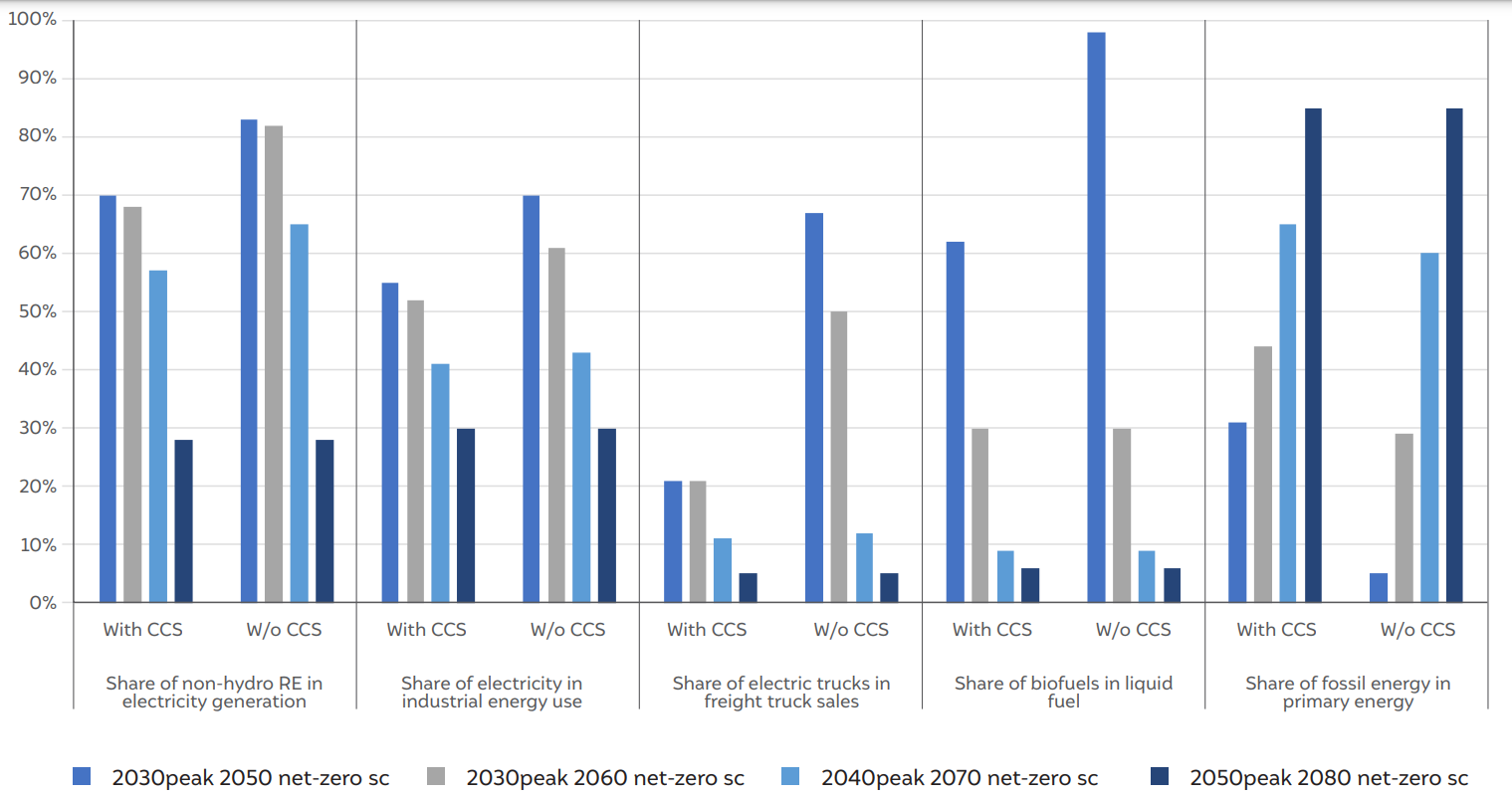
Source: Reproduced from Chaturvedi, Vaibhav. 2021. Peaking and Net-Zero for India’s Energy Sector CO2 Emissions: An Analytical Exposition. New Delhi: Council on Energy, Environment and Water
Figure above highlights that there could be a significant difference between the level of transformations required in the energy system with CCS and without CCS in the economy. In the scenario of reaching net-zero by 2050, the share of non-hydro RE, when the CCS is feasible with fossil-based electricity generation, could be 13 per cent lower than that without CCS. Additionally, the CCS technology would help in accommodating nearly 30 per cent of fossil fuel’s share in the primary energy, which otherwise needs to be only 5 per cent without CCS availability. CCS being feasible in refineries would help in promoting biofuels and require much slower transformation in the electric freight truck sales (21 per cent), which without CCS would be 67 per cent by 2050 (Chaturvedi 2021). Additionally, studies suggest that in deep decarbonisation scenarios in India, CCS has a mitigation potential of 780 Mt [million tonnes]/ year below 60 USD [US dollar]/t-CO2 in a 2°C scenario and further 250 Mt/year up to 75 USD/t-CO2 in a well below 2°C scenario (Vishwanathan et al. 2018; Garg et al. 2017). Hence, CCS could help in achieving net-zero target at the same time easing the pace of transition away from fossil energy, thus providing some relaxation in system transformation and the needed investments for this transformation. But it has to be noted that CCS feasibility is a big assumption in these cases and as discussed, the economic and policy feasibility of CCS has not gained sufficient traction in last decade in India. Nevertheless, in recent times, increasing efforts (induced by global ambitions) to push for CCUS in the Indian economy are directed at defining the techno-economics and policy for CCS, that is, R&D, finance, and policy context. In addition to these challenges, the risk associated with the storage of carbon also presents a challenge to the governance of CCS along with the above-mentioned challenges. People participation and awareness of the technology is very low, leading to a ‘not in my back yard’ (NIMBY) mind-set, elevating public concerns (Tcvetkov, Cherepovitsyn, and Fedoseev 2019). Additionally, there are questions around the liability, penalties, long-term management, and stewardship, which are also governance concerns linked to CCS and need to be focused upon if this technology penetrates the economy in a substantial manner (IRGC 2018) debate such as national communications and Biennial Update Reports (BURs), key global literature focusing on changing role of this technology across regions, and major announcements by Indian industries to capture the changing narrative of CCUS in the Indian context. In the rest of this brief, we discuss the key insights from the assessment, conclusions, and way forward, highlighting the focus areas to maintain the momentum of the CCS/CCUS debate in India.
The debate on CCUS in India has not been given a critical attention, but it is not new to the energy and climate policy space. Figure below describes the key milestones in the evolution of the CCS/CCUS debate in India. The establishment of the Indian CO2 Sequestration Applied Research (ICOSAR) Network by the Department of Science and Technology (DST), Government of India, in 2007 was one of the key developments to initiate and facilitate research dialogue on CCS applications among stakeholders (Viebahn, Vallentin, and Höller 2014; Viebahn et al. 2011; Bumb and Rituraj n.d.). In 2008, the Government of India came up with the National Action Plan on Climate Change (NAPCC), which did mention the CCS in reference to reducing emissions from coal power plants while highlighting concerns regarding its high cost and (in)stability of CO2 storage repositories (PMCCC 2008). In the Second National Communication (SNC) to the United Nations Framework Convention on Climate Change (UNFCCC) as well, India presented a demonstration project for carbon dioxide capture and storage (MoEF 2012). Soon, the CCS conversation lost its momentum in India’s growth story and climate debate. The subsequent BURs did not include the progress of CCS in the country. Both BUR-I and BUR-II did not mention much about India’s carbon capture activities (MoEFCC 2015, 2018). However, in 2015, the Conference of Parties (COP)-21 launching Mission Innovation (MI) emerged as another milestone for R&D on CCS technology in India (MoEFCC 2018)/
Figure 3 Conversation around and finances for exploring CCUS in India has gained momentum after 2015 facilitated by Mission Innovation
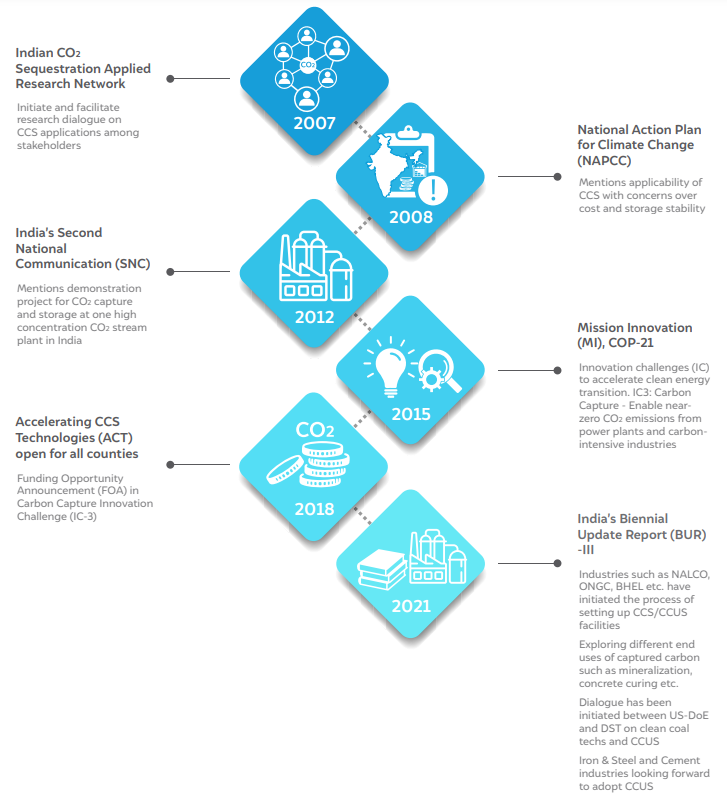
Source: Authors’ compilation
As part of Mission Innovation (MI), India is collaborating with 24-member countries and the European Union (EU) to deliver on eight innovation challenges. The innovation challenge (IC)-3 focuses on ‘Carbon capture—Enable near-zero CO2 emissions from power plants and carbon-intensive industries’ (MoEFCC 2021). Since India does not have much experience in implementing CCUS at scale, the innovation plan focuses on building and speeding up the developments through peer learning among MI nations (DBT and DST 2018). The MI countries have also agreed to double the funding from the 2015 baseline to provide a financial boost to the R&D activities for the mentioned innovation challenges (GoI 2017). Additionally, the commencement of MI has had many positive effects on the adoption of CCUS technology in India. The Department of Biotechnology (DBT) and DST, along with Accelerating CCUS Technologies (ACT) initiative under MI, has played an essential role in bringing back focus on CCS/CCUS in the Indian context by peer technology exchange and allocating funds for R&D. In the latest call for financial support, 15 ACT member countries and organisations have decided to participate. However, the funds will be allocated from national and regional budgets that support research and development as well as pilot and demonstration projects. Some of the research priorities highlighted in the third call include: efficient absorbents for CO2 absorption, economics and industry evaluation of technology, sequestration by enhanced oil recovery etc. (DBT and DST 2018). CCUS has started gaining momentum across industrial sectors in India. Heavy industries such as National Aluminium Company (NALCO), Oil and Natural Gas Corporation (ONGC), and Bharat Heavy Electricals Limited (BHEL) are initiating the process of setting up the CCUS facilities. The leading companies from the most emission-intensive iron and steel and cement industries are following the path to exploring CCUS technologies with a vision stay carbon-neutral (MoEFCC 2021). Nonetheless, the dialogue between the United States Department of Energy (US-DoE) and the DST has led to India’s participation in Accelerating CCUS Technologies (ACT), which has resulted in a US–India collaboration for CCUS development in the country (MoEFCC 2021). Also, the recently launched roadmap 2030 for India-UK future relations considers CCUS under clean energy and transport focus areas (MEA 2021). Thus, multiple initiatives highlight the resumption of the application of CCUS across industries in India. This regained thrust of the CCUS debate is likely to sustain with many nations and industries coming up with ambitious climate change mitigation targets.
In 2015, the global efforts focusing at climate change mitigation led to nationally determined contributions (NDC) by respective countries pledging to reduce emissions under the aegis of the Paris Agreement. However, studies have already stated that NDCs are not enough to even achieve the reduction of global temperature below 2°C ( R. Liu and Raftery 2021; Wang and Chen 2019). Since the mitigation targets were not ambitious enough, NDCs submitted to the United Nations Framework Convention on Climate Change (UNFCCC) by the parties include CCS only negligibly as a prospective technology in future. A review of NDCs highlights that out of 163 nations, only 13 countries and the EU (for its member countries) mentioned CCS in their declarations (Campbell et al. 2018). However, in case of mid-century strategies (MCS)4, only three out of six nations quantified the possible reduction by implementing CCS in the economy (Campbell et al. 2018).
But increasing realisation of the adverse impacts of climate change has pushed nations towards stringent climate pledges such as net-zero. Larger economies like the EU (by 2050), Japan (by 2050), and China (by 2060) have already announced their net-zero targets (Murray 2020). With the change of leadership in the United States, pledging for net-zero by 2050 is also on the priority list of the Biden administration (Mooney 2020). Simultaneously, the International Energy Agency’s (IEA) analysis on the role of CCUS in clean energy transition clearly states that achieving carbon neutrality without CCUS technology is virtually impossible (IEA 2020). In a similar direction, projections for achieving net-zero in the major economies emphasise CCS playing a prominent role in tight carbon constraints scenarios. As estimated, Europe would need a large CCS facility for capturing nearly 230–430 MtCO2/yr in 2030 and increasing it to 930–1,200 MtCO2/yr by 2050 to reach net zero by 2050 consistent with 1.5°C global temperature reduction target (Butnar, Cronin, and Pye 2020). Even an analysis of China’s net-zero ambition shows that by 2060, 16 per cent of the energy demand will be dependent on fossil fuels and would necessarily need coupling with CCS technology to achieve the target (Nature 2020; Bloomberg 2020b).
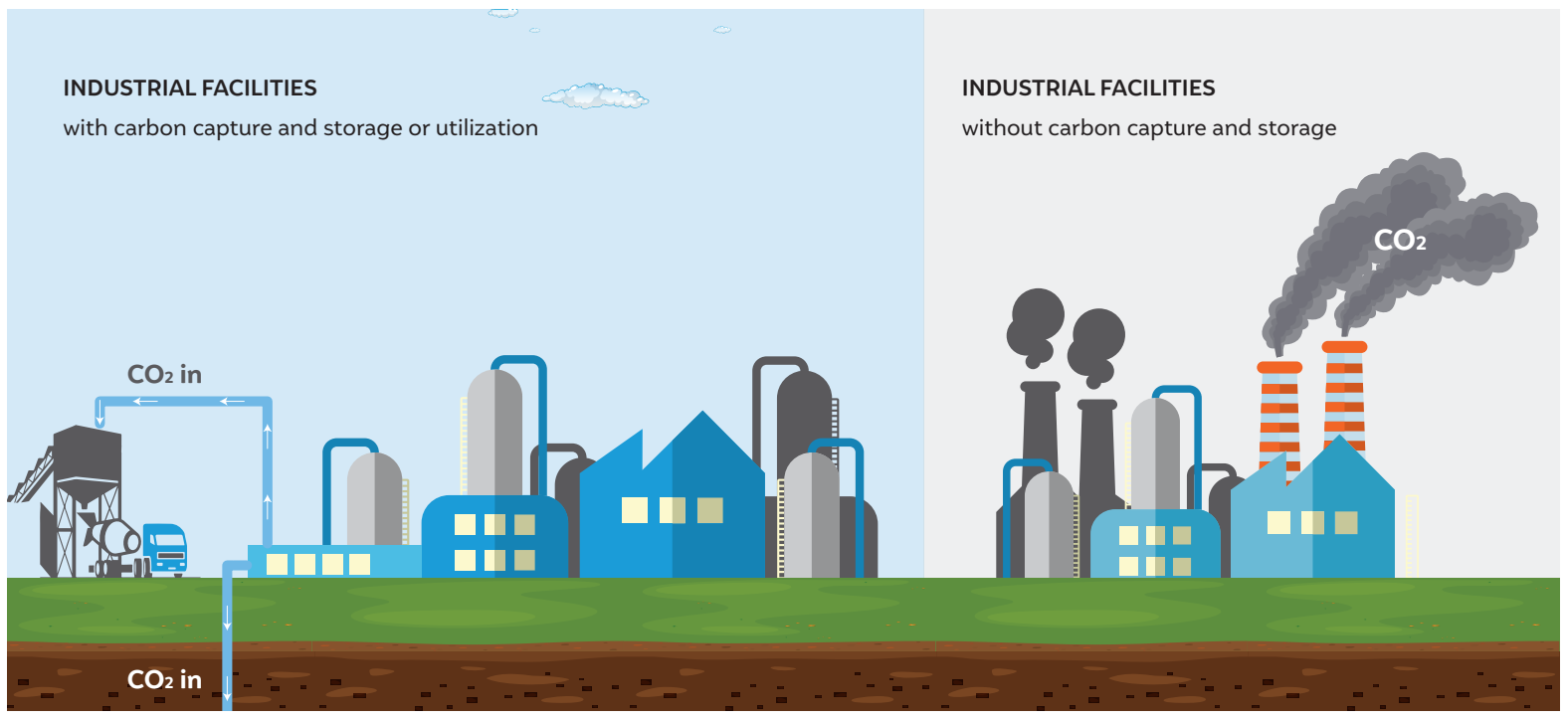
Despite the significance of CCUS in achieving global temperature reduction targets and urgency with which climate change has to be addressed, the investment and development of the CCUS project pipeline are not as fast as it should be (IEA 2020; Global CCS Institute 2019). Historically, despite announcements, the investments for financing CCS in major economies did not pick up. Out of USD 31 billion announced in 2009 by the United States, Europe, Australia, Canada, and Great Britain, only USD 3 billion was actually invested, with cancelled CCS projects in Europe largely accounting for the gap (Romasheva and Ilinova 2019). After a steady decline in CCS capacity from 2010 to 2017, it has started climbing from 2017 to 2020. As CCS regains momentum globally, the current operational capacity stands four times compared to that in 2010 (Global CCS Institute 2020a). The increasing ambitions are driving national leaderships towards more push for the adoption of CCS technology. The growing climate change mitigation ambitions and the realisation of the inevitability of CCS in the long term have started attracting investments across major nations. Table below describes the major announcements of financial support and investment initiatives from the governments of major economies for CCS facilities.
The dynamism of climate change mitigation pledges from the developed nation will impact India’s perspective and decision making. The escalating global ambitions are likely to build diplomatic pressure on India to either go for net-zero or raise its mitigation targets significantly. India is nonetheless praised for demonstrating leadership in climate change mitigation initiatives. Also, India is only one of the G20 nations to be on track of reducing the temperature rise to 2°C. Being a leader, India holds a significant position in global climate change politics. However, as more and more G20 nations5 are coming up with carbon neutrality targets, India not planning for matching ambitious targets could result in the country losing its leadership position in international climate change politics.
Table 1 Major announcements for financial support and incentives for CCS/CCUS adoption
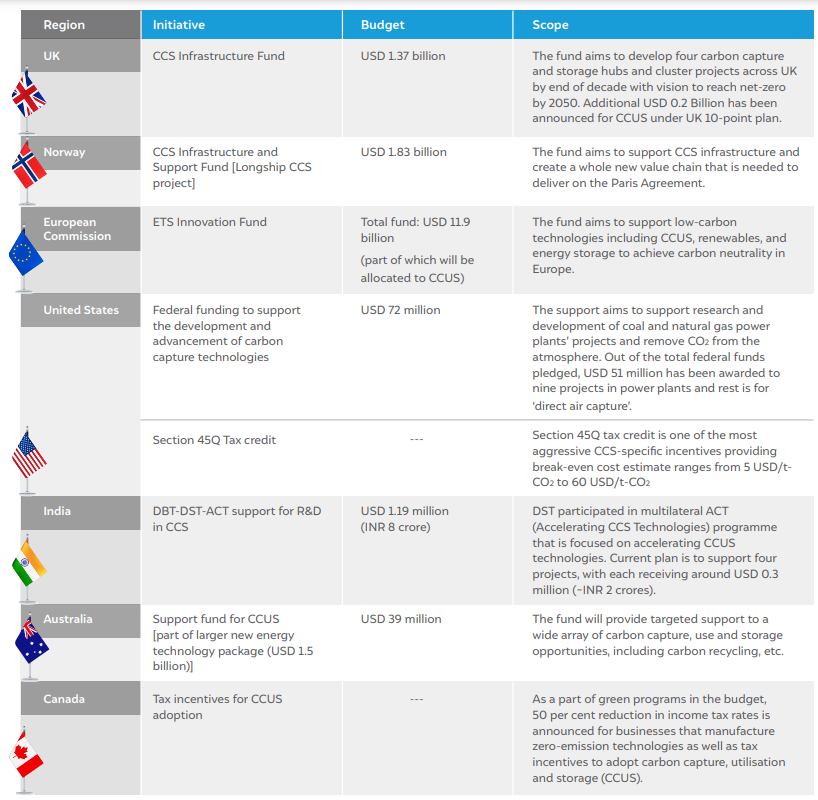
Source: Authors’ compilation
Additionally, the EU is one of the early movers to go for the Carbon Border Adjustment Mechanism (CBAM) to avoid ‘carbon leakage’. The CBAM could induce a jolt in the world trade and revise the terms of competitive advantages across nations (BCG 2020). On the one hand, India is moving closer to the free trade deal with the EU, which would make it easy for European players to enter the Indian market (Business Standard 2020). On the other, the EU envisages imposing a carbon tax on imports from high-emitting markets (Bloomberg 2020). The coexistence of these deals is likely to impact the competitiveness of Indian industries globally and locally. These concerns have induced the private sector in India to go beyond the usual trajectories and initiate pilots for CCS/CCUS facilities in industries.
Currently, achieving the deep decarbonisation potential in industries is more challenging compared to that in any other sector. The reasons are the limited possibility of switching, both because of existing investment in conventional processes and technology advancement limitations such as dependence on specific heatbased processes on fossils (Bühler, Müller Holm, and Elmegaard 2019; Deason et al. 2018). In this context, CCS/CCUS is widely discussed as a crucial mitigation technology to aid the industry significantly.
The industrial sector will continue to be crucial in terms of energy and emission in the Indian economy. The sector is expected to hold 58 per cent share in the total final energy consumption by 2050 (Chaturvedi, Nagar Koti, and Chordia 2021). Whereas its share in total economy wide emissions will be around 31 per cent by mid-century (Chaturvedi, Nagar Koti, and Chordia 2021). Additionally, the industrial sector is expected to be dominated by fossil energy sources, which accounted for 66 per cent of the total industrial energy consumption in 2017 (IEA 2018) and likely to decline by only 2 per cent to 64 per cent by 2050 (Chaturvedi, Nagar Koti, and Chordia 2021). The expected long-term dependence on fossil fuels in India’s industrial sector makes the role of CCUS technologies indispensable in deep decarbonisation scenarios in this sector. Despite the importance of CCUS technologies for the Indian industry, there is a lack of policy support in promoting these mitigation technologies in the industry. However, industry leaders being cognisant of the business risks in long-term sustainability (to remove the tag of being emission-intensive), have undertaken a few pilots for implementing CCS/CCUS in selected plants.
As mentioned in the earlier section, public sector undertakings such as NALCO, ONGC, and BHEL are taking up CCS pilots (MoEFCC 2021). NALCO has commissioned a pilot-cum-demonstration CO2 sequestration plant (Gupta and Paul 2019). ONGC has signed a memorandum of understanding (MoU) with ILFS Energy and Tamil Nadu Power Company (ITPCL) in 2018 to inject CO2 captured at the ITPCL plant into oil fields of ONGC Cauvery Asset (Cornot-Gandolphe 2019). Various reasons such as scalability of the technology, many successful demonstrations, ability to generate revenue while offsetting the high incurred cost of CCUS and being a precursor to pure sequestration projects makes EOR a preferred choice for CCUS projects. Since the oil discoveries are getting fewer, utilisation of CO2 through processes like EOR showcase a great potential to rejuvenate mature oil fields (Mishra, et al. 2019). Hence, ONGC and Indian Oil Corporation Limited (IOCL) have signed an MoU for CO2 based Enhanced Oil Recovery (EOR) by injecting CO2 captured from IOCL’s Koyali refinery. The effort aims to reduce India’s carbon emission targets set forth in COP21 while enhancing production from domestic fields (ONGC 2019). According to the estimates, the ONGC’s EOR project has the sequestration potential of around 5-8 MMT of CO2 through structural, solubility and residual trapping mechanisms (Mishra, et al. 2019).
Additionally, private players such as Dalmia Cement, one of the leading cement manufacturers in the country, are exploring the adoption of CCS technology. The active participation of the private sector in the direction of deep decarbonisation of industries could be a gamechanger for India’s industrial sector. Hence, the case study of Dalmia Cement is highlighted in this brief.
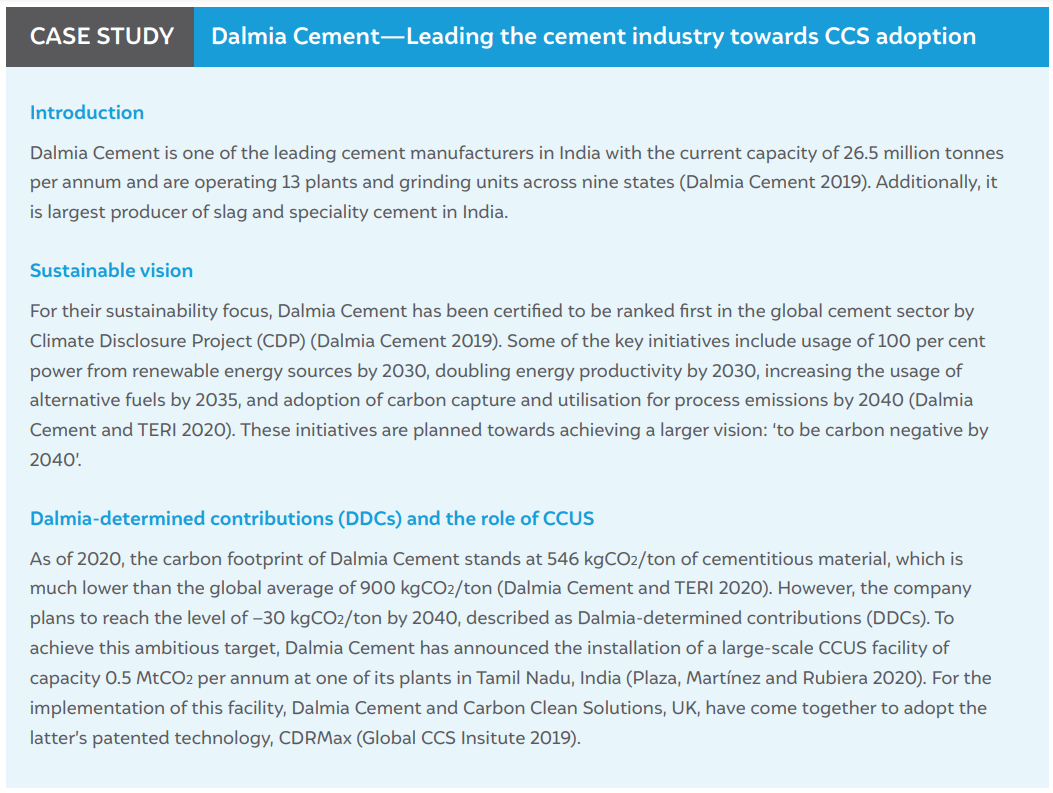
It is evident from the case of Dalmia Cement that achieving ambitious targets such as net-zero for hard to abate sectors that have to deal with process emissions essentially has to include CCUS technology as part of the strategy, even if such industries are one of the most efficient ones across the globe. Similarly, Tata Steel’s latest technology, ‘HISARNA’, is being planned to be implemented with the CCS technology. However, HISARNA technology with CCS is still under development and timeline of implementation is also unclear (TNO 2020).
Nevertheless, with global level changes in mitigation strategies such as Carbon Border Adjustment Tax in the EU to avoid ‘carbon leakage’, industries need to transition beyond the ‘business as usual’ to the lesser carbon-intensive state to stay competitive in the European markets. Nonetheless, considering the urgency with regard to climate change mitigation actions and ambitious climate pledges announced by several nations, more initiatives on the lines of EU’s Carbon Border Adjustment Tax can be anticipated. Thus, the role of CCUS is being recognised by the industries, but more stakeholders are needed for the transition to promote the adoption of CCS/CCUS technology in India.
The changing narratives towards the prospects of implementing CCS/CCUS technology across the globe, including India are evident, primarily driven by climate change mitigation ambitions. Our assessment highlights the following points:
After lying dormant for a decade, the CCUS debate has been reignited in India’s climate change mitigation conversations. The discussions were first initiated in 2007, but they lost momentum over time. With India joining Mission Innovation in 2015 and with several nations making ambitious mitigation pledges such as carbon neutrality in recognition of an urgent need to address climate change, CCUS is regaining its momentum as an essential technology in the presence of fossil-based industries across nations, including India. Though CCUS could play a significant role in the power and industrial sectors, the power sector relies heavily on renewables in India at present. However, in long-term deep decarbonisation scenarios, CCUS could play an important role to achieve net-zero emissions in energy systems. Simultaneously, the industrial sector continues to face multiple challenges hindering its transformation. Consequently, with the growing acceptance of challenges and the need to mitigate the industrial sector emissions, CCUS is being adopted as a pilot by many Indian industries.
To address the challenges CCUS faces in India, there is a need to develop and evolve an ecosystem supporting CCUS facilities in the Indian market. Success of CCUS is not only impeded by technology which will be advancing in coming years but also by the lack of a policy ecosystem. The ecosystem should be built and strengthened around the essential pillars, namely, R&D, policy, finance, and governance. Except for MI-DBTDST projects, no focused research is being facilitated for CCUS. However, an India-specific comprehensive analysis needs to be undertaken to understand the challenges and the local solutions that are possible. Besides this, research and communication are also required on the policy front to understand the changing requirements and implications of policies on the role of CCUS, especially in the industrial sector. There is a need for demonstration projects to increase the confidence of stakeholders with the technology and better understand the uncertainties associated with it. Additionally, market-based mitigation mechanisms could play a key role in promoting CCUS facilities among industries and the inclusion of CCUS as a crucial ecosystem enabler. The cost of CCUS is very high despite decades of research highlighting the requirement of alternative finance mechanisms and support to help consumers adopt this expensive yet relevant technology . As the uncertainty and risks of CCUS are well known, the longterm sustainability and associated trade-offs of CCUS penetration in the ecosystem should be focused upon. Nonetheless, the CCUS technology is relatively new to India compared to the developed nations and hence it requires more comprehensive research, actions, and discussions to keep the debate going while discussing India’s low-carbon story.
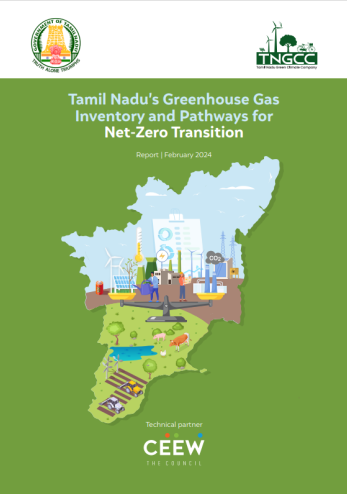
Tamil Nadu’s Greenhouse Gas Inventory and Pathways for Net-Zero Transition
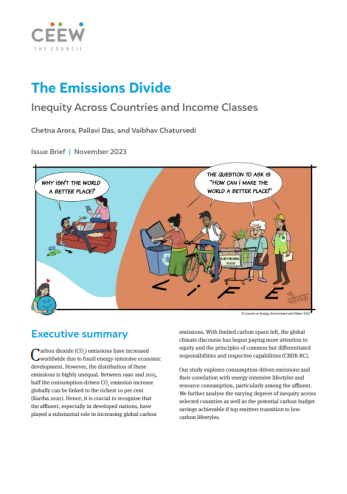
The Emissions Divide: Inequity Across Countries and Income Classes

Implications of an Emissions Trading Scheme for India’s Net-zero Strategy

Demystifying Carbon Emission Trading System through Simulation Workshops in India